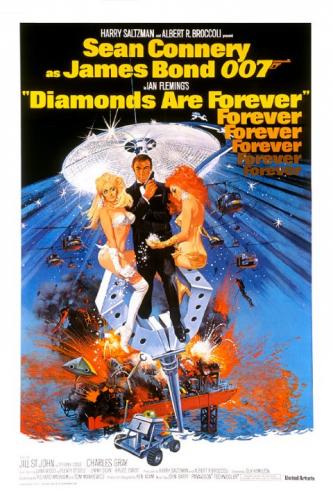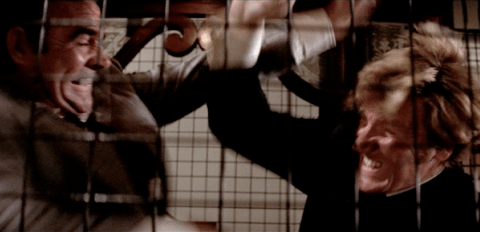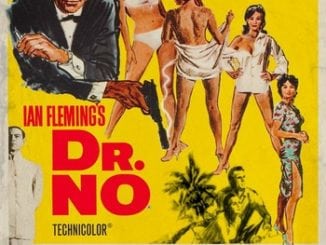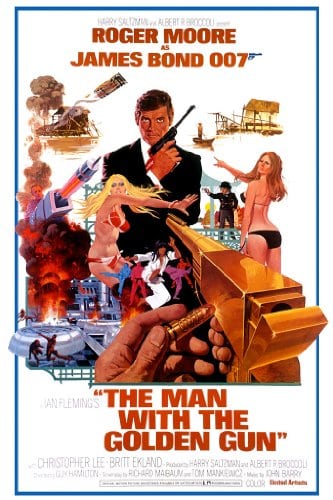Diamonds Are Forever (1971)
Directed by: Guy Hamilton
Written by: Ian Fleming, Richard Maibaum
Starring: Charles Gray, Jill St. John, Norman Burton, Sean Connery
UK
AVAILABLE ON BLU-RAY AND DVD
RUNNING TIME: 121 min
REVIEWED BY: Dr Lenera, Official HCF Critic
Members of a diamond smuggling chain are being murdered by assassins Mr Wint and Mr Kidd so, after hunting down and killing Ernst Stavro Blofeld. James Bond is asked by M to investigate the possible stockpiling of diamonds which could cause economic collapse. Impersonating professional smuggler and assassin Peter Franks, 007 goes to Amsterdam to meet contact and fellow smuggler Tiffany Case, kills Franks and switches IDs to make it seem like Franks is Bond, then with her smuggles diamonds to Los Angeles inside Franks’ corpse. There, Shady Tree, the next smuggler in the chain finds that the diamonds are fakes planted by Bond and the CIA, so Bond tells his CIA pal Felix Leiter to ship him the real diamonds. He also finds that Tree is performing as a comedian in a casino-hotel owned by the reclusive billionaire Willard Whyte who hasn’t been seen for three years….
The fact that Diamonds Are Forever was chosen by IGN as the third worst Bond film [behind only The Man With The Golden Gun and Die Another Day, and I would say that none of those three films belong in the bottom three] is representative of the general low opinion people seem to have of it. It may be the weakest Bond flick to its date, and doesn’t work very well as a follow-up to the glorious On Her Majesty’s Secret Service. It’s storyline sometimes seems like it was made up on the spot, and aside from the odd moment, a sense of danger is almost completely missing, something which also takes away much of the excitement no matter how much action is thrown at the viewer. While not as large scale and unbelievable as You Only Live Twice, it makes even less sense. However, I think that this very campy, goofy effort works a lot better if you basically consider it as a Roger Moore 007 film without Moore in it, because, aside from being surprisingly vicious in places, that’s what it basically it is, and I wonder that if Moore had starred in it then it may be liked a bit more. It moves at a very fast clip, is often very funny with more chucklesome lines than in any other Bond film, and there are plenty of memorable moments and inventive touches. Perhaps considering the high quality of most of the Bond films [I rank the majority of them around the 7 or 8 out of 10 mark], it’s not that good a 007 film, but it’s certainly an okay one and provides two hours of solid escapist fun.
Initially this was to be a revenge-themed sequel, but after George Lazenby’s departure, Richard Maibaum was asked to write a Goldfinger sequel. Auric Goldfinger’s twin [to be Gert Frobe again] was a shipping magnate with a laser on a tanker. Set in India and Thailand, it had an elephant hunt and a climax where Las Vegas gangsters in an assortment of boats and ships chase Goldfinger. A dream by Albert R. Broccoli where his friend, the reclusive Howard Hughes, was replaced an impostor, was also an influence. Then United Artists got Tom Mankiewicz to do a rewrite and add a lighter and more American angle. The book was barely an influence from the start, and Ian Fleming’s diamond smuggling thriller only really provided some characters, character names and a few details [i.e. diamond teeth]. Peter Hunt could only direct after he finished another film, so Guy Hamilton was asked back. John Gavin, Adam West, Michael Gambon and Burt Reynolds were tested for 007 but UA wanted Sean Connery back, who only agreed if he was paid £1.25 million and able to do two films of his choice. Raquel Welch, Jane Fonda and Faye Dunaway were considered for Tiffany Case. The locations were in and around Las Vegas, Amsterdam , Lufthansa’s hangar in Germany, and the home of Kirk Douglas which became Tiffany’s house. There, Lana Wood almost drowned as she actually had her feet tied to a cement block on the bottom. The planned climax of Bond chasing Blofeld to a salt mine and fighting him was cut, while scenes including Sammy Davis Jr, Wint and Kidd killing Tree, and Bond having a drink with Plenty O’ Toole were cut, and others, notably the Bond/Tiffany love scene on the water bed, shortened. Diamonds Are Forever made just over the amount of money that You Only Live Twice did. The BBFC removed some shots from two of the fight scenes, and, while videos and DVDs were uncut, the film was raised to a ‘12’ on Blu-ray.
Diamonds Are Forever begins like it’s following on from the previous film, with a very determined and rather brutal Bond attacking various people, including a girl, in his search for Blofeld, though the actual showdown is incredibly lame – the criminal mastermind waits for Bond to face him before he lunges at him, Bond knocks him onto a bed, and that’s it. The titles, which begin with Blofeld’s diamond collared cat moving between the usual shadowed females, rather give away the fact that Blofeld will turn up later, and along with hands cupping gemstones, comprise one of Maurice Binder’s weaker efforts, but at least we have the fabulous theme song, with Shirley Bassey virtually salivating as she sings the risqué lyrics [composer John Barry told her to imagine she was singing about a penis, and co-producer Harry Saltzman hsted the song]. There’s soon a nice moment where Bond shows off his knowledge of sherry but then surprisingly reveals that there’s one thing he’s not an expert of – diamonds. The film is relatively serious at first, and the early fight between him and Franks in a lift is gratifyingly violent despite the limited space and the fact that Hunt is no longer around to do his trademark stylish editing, something which is missed throughout.
After some bits in Amsterdam, the film then moves to Las Vegas and mostly stays there. Some find the tackiness of this setting inappropriate for 007, but I think he fits in perfectly. The biggest problem the film soon faces is that its plot is, despite some cool ideas like the hermit-like billionaire who turns out to be the man with the cat, quite poorly put together, full of coincidences and tenuous links between the various parties and events, and we even get the odd totally dumb moment like when Tiffany notices a woman carrying a cat and follows her to her car, where she pushed into the vehicle and realises that the woman is Blofeld in drag. Why on earth does she follow him in the first place? It’s not like she’s met Blofeld befor and would recognise him. Matters resolve into a series of set pieces usually involving people trying to kill or catch 007, most often the gay Wint and Kidd [oh how the PC set would whinge about this film if it were made today!], who are actually a great pair of villains, Wint’s harmless looks and manner contrasting well with Kidd’s more obviously malicious nature. Of course Blofeld doesn’t just shoot Bond – he gets him to go into a lift where gas knocks him out, then has Wint and Kidd drive him to where they’re building a pipeline and throw him into a pipe. This time Blofeld, armed with a satellite equipped with a laser powered by those diamonds, wants to hold an international auction for global nuclear supremacy, and even this part of the plot isn’t satisfactorily explained, while the oil rig climax is surprisingly unexciting and the much anticipated Bond/Blofeld showdown disappointingly consists of Bond bashing about Blofeld’s submarine with a crane.
There’s still much to enjoy. The Bond/Tiffany relationship, built on mistrust and duplicity, is quite interesting even if the slightly vulgar Tiffany becomes a clumsy idiot who falls into the sea when she fires a gun and Jill St John understandably seems a little lost with the character. It’s disappointing how Bond’s fight with the panther-like females Bambi and Thumper is resolved when they all jump into a swimming pool. However, Bond almost being cremated is a rare moment of real peril because you know there’s no way whatsoever he can get out. He doesn’t even have much in the way of gadgets in this one. A chase with bikes and Bond in a moon buggy is certainly different if unexciting [though why on earth are two astronauts on a mock lunar landscape moving in slow motion while Bond runs through it], and the following police chase boasts some great car stunts, culminating in the famous car tilt through an alleyway, even though one can see crowds of extras watching the early parts. And, while there’s more smut than normal, Mankiewicz’s funny lines are plentiful if often corny. “Very moving”, “heartwarming”, “a glowing tribute” say Wint and Kidd to each other as they’re trying to cremate Bond. Perhaps my favourite laugh is when Plenty O’ Toole, Bond’s Las Vegas pickup [come to think of it, he only sleeps with one woman!], is thrown out of a hotel window to land in a swimming pool. “Exceptionally fine shot” commends Bond. “I didn’t know there was a pool down there” replies the hood. With all this comedy, it’s odd that Diamonds Are Forever is probably the cruellest and most violent early Bond, with a surprising amount of blood [most deaths tend to be bloodless in these films] for a start.
Unlike in You Only Live Twice, Connery seems to be enjoying himself, and he’s very sharp, though he seems to have aged rather more than four years. Charles Gray is a rather camp and unmenacing Blofeld, though he delivers his lines with a certain relish, brushing aside reports of a threat with: “The great powers flexing their muscles like a gang of impotent beach boys”. Norman Burton is a stocky, colourless Felix Leiter. Paul McCartney was initially asked to do the score, but John Barry again contributes a marvellous effort, with no sense of tiredness even if its sound unsurprisingly recalls Goldfinger’s score a bit. The main theme functions mostly as a love theme and receives few variations, but there’s some fine action music [the way he scores the moon buggy chase, enhancing the absurdity without degenerating into comedy music, is genius], a variation on the You Only Live Twice Space March, 007 again, and lots of catchy jazzy source tunes for the Las Vegas scenes. He even wrote the music for the cremating scene where it functions as both deliberately over the top source music and score. I always enjoy Diamonds Are Forever when I watch it, even if doesn’t really fit together, a few major blunders are made, and it’s not the On Her Majesty’s Secret Service sequel that it ought to have been, though, as I said in my review for the 1969 film, that one almost seems to exist in a different universe. You could place Diamonds Are Forever just after You Only Live Twice, and they would flow quite well. All things considered, it’s a good, if not great, precursor to the Moore era and a fine Bond to just put on and relax to, if certainly not to think about.










Be the first to comment